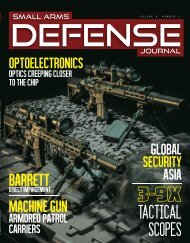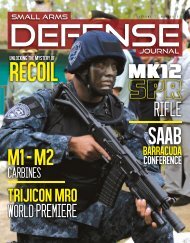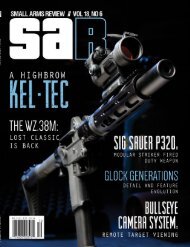Create successful ePaper yourself
Turn your PDF publications into a flip-book with our unique Google optimized e-Paper software.
Less-Lethal<br />
Launchers During<br />
Protest in Turkey<br />
BY N.R. JENZEN-JONES<br />
Crowd control actions executed by<br />
Turkish police in 2013 have showcased<br />
the employment of several<br />
less-lethal launchers. Aside from a<br />
range of medium-calibre riot guns<br />
(including 37/38mm Federal Riot Guns,<br />
37/38mm Penn Arms PL-8 rotary launchers,<br />
and MKE 40mm launchers) firing CS,<br />
impact, and possibly OC munitions, three<br />
other less-lethal launchers have been observed.<br />
Each of these launchers have the<br />
ability to fire multiple projectiles quickly,<br />
and a capacity which exceeds that<br />
of the typically-employed 12 gauge and<br />
37/38mm and 40mm systems. Both of<br />
these weapons appear to be in use by the<br />
Çevik Kuvvet anti-riot police unit. There<br />
has been some confusion about what these<br />
systems are, where they are produced, and<br />
what their capabilities are.<br />
The Fabrique Nationale d’Herstal<br />
(FNH) FN 303 is a purpose-designed,<br />
semiautomatic weapon that uses compressed<br />
air to propel projectiles approximately<br />
100 meters. It functions primarily<br />
as an impact weapon, although several of<br />
the available (FN-proprietary) projectiles<br />
have secondary effects, as described below.<br />
The weapon is constructed primarily<br />
of polymer, and is relatively lightweight at<br />
2.2 kg. There is a Picatinny rail along the<br />
top of the receiver, and folding front and<br />
rear iron sights. An EOTech holographic<br />
sight, specifically calibrated to match the<br />
FN 303’s ballistic profile, is also available.<br />
The FN 303 is fed from a 15-round detachable<br />
drum magazine, which features a clear<br />
polymer back plate to allow for rapid identification<br />
of round count and type. Magazine<br />
changes can be accomplished in a few<br />
seconds, and magazines can be reloaded in<br />
around 30 seconds. The weapon is factory-set<br />
to a muzzle velocity of 86-91 metres<br />
per second. Compressed air canisters are<br />
factory-specified, and the user manual<br />
warns against using other containers. One<br />
full tank should last for at least 100 shots.<br />
FN 303 ammunition has also been<br />
documented in Turkey with 18mm (.68<br />
calibre) glycol-based impact munition for<br />
the FN 303. Other available projectiles<br />
include powder-based impact, impact<br />
plus indelible marker paint, impact plus<br />
washable marker paint, and impact plus<br />
irritant powder. The munitions all contain<br />
a bismuth payload to provide weight for<br />
impact, and are fin-stabilised to provide<br />
accuracy at longer ranges than many other<br />
less-lethal launchers. All have the primary<br />
effect of incapacitating the target or<br />
degrading his or her will to fight through<br />
force of impact.<br />
Marker rounds have the secondary<br />
effect of assisting authorities in identifying<br />
potentially threatening individuals.<br />
The irritant projectile contains a synthetic<br />
capsaicin known as PAVA (for pelargonic<br />
acid vanillylamide; also known as nonivamide),<br />
which delivers a disruptive or<br />
incapacitating effect. At close range, these<br />
projectiles have been known to penetrate<br />
sheetrock, hollow-core doors, and auto<br />
glass and still affect the target behind<br />
cover. FN Herstal estimates the range for<br />
point targets at 50 meters, but the weapon<br />
can be effective out to 100 meters against<br />
area targets, such as crowds. FNH USA estimates<br />
the minimum engagement range<br />
at 1 meter, but U.S. DoD policy forbids engagement<br />
at ranges less than 5 meters.<br />
As with other impact munitions such<br />
as rubber bullets or 37/40mm impact projectiles,<br />
it is essential to engage targets in<br />
the limbs or torso to avoid serious injury.<br />
The FN 303 manual warns that, “Death or<br />
serious injury may result from projectiles<br />
striking the head or neck.” It is important<br />
to remember that there are risks inherent<br />
to the use of all less-lethal systems; this is<br />
precisely why there is a trend towards the<br />
use of the term ‘less-lethal’ rather than<br />
‘non-lethal’. Comparatively safe systems,<br />
such as the FN 303, are often a preferable<br />
alternative to the use of live rounds or other,<br />
more dangerous less-lethal solutions.<br />
It appears that the Turkish police<br />
tested the FN 303 in 2008, and introduced<br />
it into service in 2010. A 2010 article<br />
from Dünya Bülteni, a Turkish news<br />
24 SADEFENSEJOURNAL.COM









